Oral Health Education in Type 1 Diabetic Patients
Added on 2022-08-13
97 Pages19326 Words435 Views
1
The effectiveness of Verbal and Nonverbal Oral Health Clinical Education in improving Oral
Health in Male and Female Type 1 Diabetic Patients.
A dissertation submitted to the University of Manchester for the degree of Masters of
Restorative and Aesthetic Dentistry in the Faculty of Biology, Medicine and Health
2018-2020
Yasser khan
10328243
Supervised by
Azad Aziz
DIVISION OF DENTISTRY
The effectiveness of Verbal and Nonverbal Oral Health Clinical Education in improving Oral
Health in Male and Female Type 1 Diabetic Patients.
A dissertation submitted to the University of Manchester for the degree of Masters of
Restorative and Aesthetic Dentistry in the Faculty of Biology, Medicine and Health
2018-2020
Yasser khan
10328243
Supervised by
Azad Aziz
DIVISION OF DENTISTRY
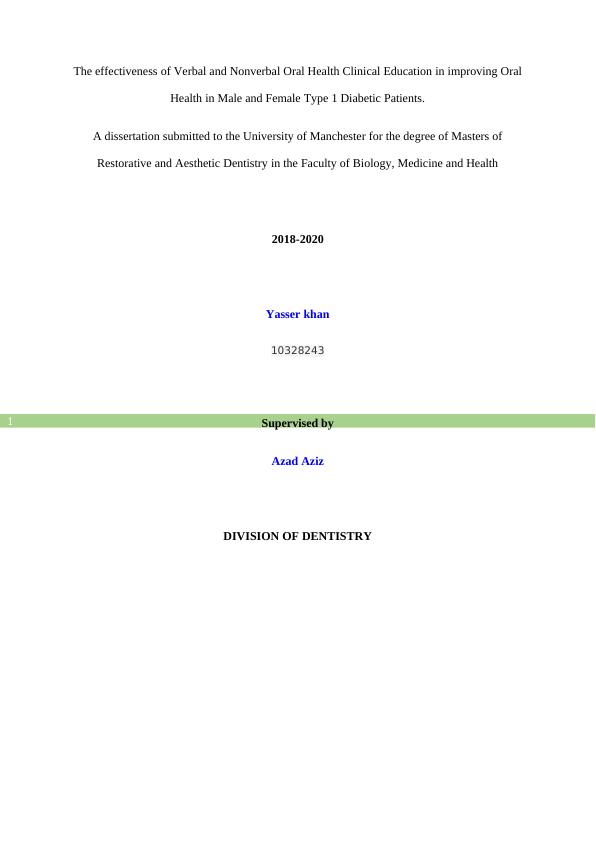
2
Table of Contents
Abbreviation...............................................................................................................................6
Abstract......................................................................................................................................7
Declaration.................................................................................................................................8
Author information...................................................................................................................10
Background and Introduction...............................................................................................11
Definitions................................................................................................................................11
Hypotheses...............................................................................................................................15
Aims and objectives.................................................................................................................16
Research Question................................................................................................................16
Hypotheses...........................................................................................................................16
Research Aim.......................................................................................................................16
Objectives.............................................................................................................................16
Literature review......................................................................................................................17
Introduction/ Rationale.........................................................................................................17
Search strategy.....................................................................................................................19
Collection of the data...........................................................................................................20
Critique of the methodology used........................................................................................28
Assess for risk of bias..........................................................................................................34
Conclusion............................................................................................................................35
Study Design and methodology...............................................................................................37
Table of Contents
Abbreviation...............................................................................................................................6
Abstract......................................................................................................................................7
Declaration.................................................................................................................................8
Author information...................................................................................................................10
Background and Introduction...............................................................................................11
Definitions................................................................................................................................11
Hypotheses...............................................................................................................................15
Aims and objectives.................................................................................................................16
Research Question................................................................................................................16
Hypotheses...........................................................................................................................16
Research Aim.......................................................................................................................16
Objectives.............................................................................................................................16
Literature review......................................................................................................................17
Introduction/ Rationale.........................................................................................................17
Search strategy.....................................................................................................................19
Collection of the data...........................................................................................................20
Critique of the methodology used........................................................................................28
Assess for risk of bias..........................................................................................................34
Conclusion............................................................................................................................35
Study Design and methodology...............................................................................................37
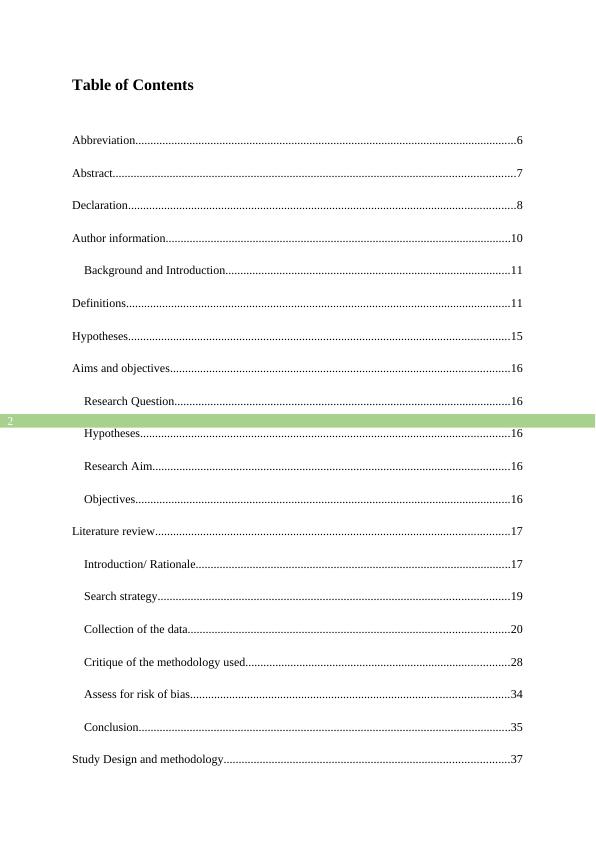
3
Executive summary..................................................................................................................37
Table for abbreviations............................................................................................................38
Introduction..............................................................................................................................39
Literature review......................................................................................................................39
Research question.....................................................................................................................43
Research aim........................................................................................................................43
Research objectives..............................................................................................................43
Methodology............................................................................................................................43
Study design.........................................................................................................................43
Study population and sampling............................................................................................44
Randomisation......................................................................................................................45
Consent process....................................................................................................................45
Oral health training sessions................................................................................................46
Schedule of training.............................................................................................................47
Schedule of assessment........................................................................................................48
Data management.....................................................................................................................48
Data collection.................................................................................................................48
Data analysis....................................................................................................................51
Expected outcomes...................................................................................................................51
Ethical issues............................................................................................................................52
Roles and responsibilities of each team member.....................................................................52
Protocol ready..........................................................................................................................53
Executive summary..................................................................................................................37
Table for abbreviations............................................................................................................38
Introduction..............................................................................................................................39
Literature review......................................................................................................................39
Research question.....................................................................................................................43
Research aim........................................................................................................................43
Research objectives..............................................................................................................43
Methodology............................................................................................................................43
Study design.........................................................................................................................43
Study population and sampling............................................................................................44
Randomisation......................................................................................................................45
Consent process....................................................................................................................45
Oral health training sessions................................................................................................46
Schedule of training.............................................................................................................47
Schedule of assessment........................................................................................................48
Data management.....................................................................................................................48
Data collection.................................................................................................................48
Data analysis....................................................................................................................51
Expected outcomes...................................................................................................................51
Ethical issues............................................................................................................................52
Roles and responsibilities of each team member.....................................................................52
Protocol ready..........................................................................................................................53
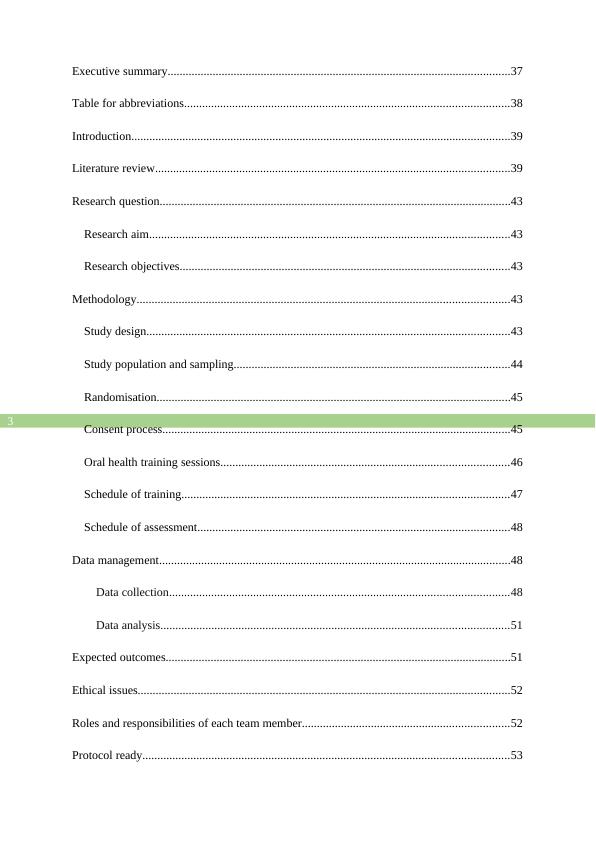
4
Timeline of the study...............................................................................................................53
Data management, quality assurance and statistical analysis..................................................57
1. Data Collection and Management........................................................................................57
2. Quality Assurance................................................................................................................60
3. Sample size calculation........................................................................................................60
4. Hypotheses...........................................................................................................................62
5. Qualitative Analysis.............................................................................................................62
6. Statistical Analysis...............................................................................................................65
6. Critical Implication..............................................................................................................68
Ethics........................................................................................................................................69
Participant Information Sheet..................................................................................................69
Consent Form...........................................................................................................................73
Final Sections and Appendices................................................................................................74
Budget......................................................................................................................................74
Collaborations..........................................................................................................................75
References................................................................................................................................77
Appendix-A..............................................................................................................................85
Search results.......................................................................................................................85
Appendix-B..............................................................................................................................87
Interview questions..............................................................................................................87
Mucosal-Plaque Score (MPS)..............................................................................................88
Beck Oral Assessment Score (BOAS), modified.................................................................89
Timeline of the study...............................................................................................................53
Data management, quality assurance and statistical analysis..................................................57
1. Data Collection and Management........................................................................................57
2. Quality Assurance................................................................................................................60
3. Sample size calculation........................................................................................................60
4. Hypotheses...........................................................................................................................62
5. Qualitative Analysis.............................................................................................................62
6. Statistical Analysis...............................................................................................................65
6. Critical Implication..............................................................................................................68
Ethics........................................................................................................................................69
Participant Information Sheet..................................................................................................69
Consent Form...........................................................................................................................73
Final Sections and Appendices................................................................................................74
Budget......................................................................................................................................74
Collaborations..........................................................................................................................75
References................................................................................................................................77
Appendix-A..............................................................................................................................85
Search results.......................................................................................................................85
Appendix-B..............................................................................................................................87
Interview questions..............................................................................................................87
Mucosal-Plaque Score (MPS)..............................................................................................88
Beck Oral Assessment Score (BOAS), modified.................................................................89
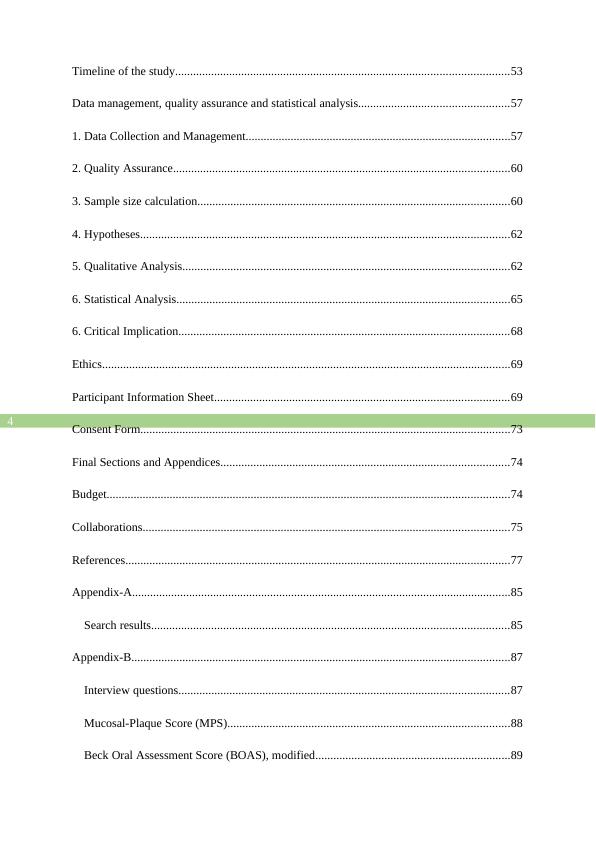
5
Oral Health Assessment Tool...............................................................................................90
Mucosal-Plaque Score (MPS)..............................................................................................92
Beck Oral Assessment Score (BOAS), modified.................................................................93
Oral Health Assessment Tool...............................................................................................94
Introductory Letter...............................................................................................................95
Interview questions..............................................................................................................96
Abbreviation
T1D Type 1 diabetes
Oral Health Assessment Tool...............................................................................................90
Mucosal-Plaque Score (MPS)..............................................................................................92
Beck Oral Assessment Score (BOAS), modified.................................................................93
Oral Health Assessment Tool...............................................................................................94
Introductory Letter...............................................................................................................95
Interview questions..............................................................................................................96
Abbreviation
T1D Type 1 diabetes
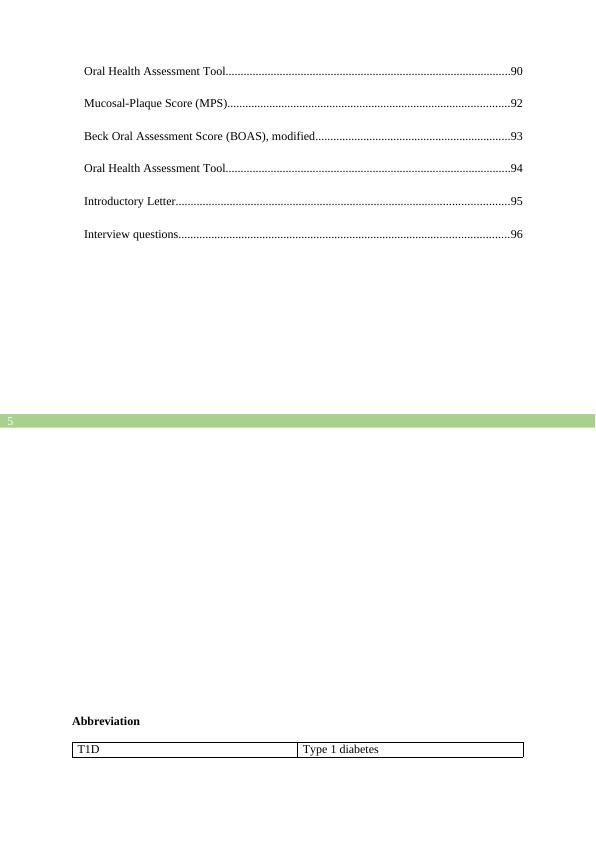
6
HLA human leukocyte antigen
AIHW Australian Institute of Health and Welfare
DMFT Decay-missing- filled teeth
CPITN index Community Periodontal Index of Treatment
Needs index
CRP level C-Reactive Protein level
FPG Fasting Plasma Glucose
HbA1c glycosylated hemoglobin
PI Plaque Index
GI Gingival index
PD Pocket Depth
CAL Clinical Attachment Level
NSPT Non-Surgical Periodontal Treatment
OHI Oral Hygiene Instructions
RCT Randomized Control Trial
HLA human leukocyte antigen
AIHW Australian Institute of Health and Welfare
DMFT Decay-missing- filled teeth
CPITN index Community Periodontal Index of Treatment
Needs index
CRP level C-Reactive Protein level
FPG Fasting Plasma Glucose
HbA1c glycosylated hemoglobin
PI Plaque Index
GI Gingival index
PD Pocket Depth
CAL Clinical Attachment Level
NSPT Non-Surgical Periodontal Treatment
OHI Oral Hygiene Instructions
RCT Randomized Control Trial
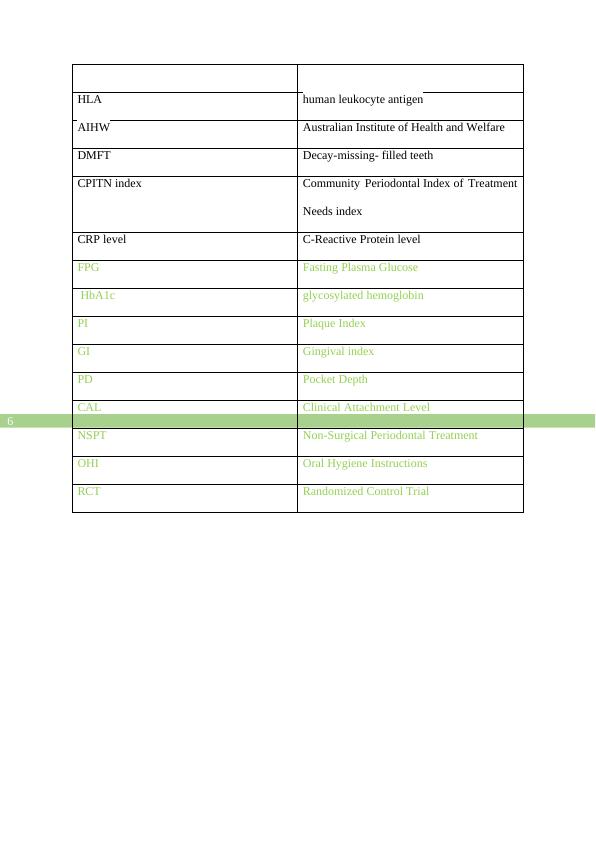
7
Abstract
Type 1 diabetes (T1D) is prevalent among children and adolescents and creates an impact on
their health and wellbeing. People suffering from T1D are at an increased risk of developing
dry mouth, periodontitis, gingivitis, burning mouth syndrome and poor healing of the
damaged oral tissues. This research proposal aims to evaluate whether verbal and nonverbal
training helps in improving oral health of T1D patients, when compared to standard
instructions.
This study includes 30 participants in this study while dividing the participants into two
groups, 15 participants in experimental and 15 participants with control. Initially, an
interview will be done to identify their current awareness and Oral hygiene practices to
maintain good oral health. Experimental group has been provided with verbal and nonverbal
training programs and control group has been provided with only standard oral hygiene
instructions. Finally, multiple oral assessment tools are used to compare the resulting
improvement in oral health. Pre-test, post-test with comparative T-test analysis (both one tail
and two tail) will be done to compare the results of experiment and control group of
participants.
Abstract
Type 1 diabetes (T1D) is prevalent among children and adolescents and creates an impact on
their health and wellbeing. People suffering from T1D are at an increased risk of developing
dry mouth, periodontitis, gingivitis, burning mouth syndrome and poor healing of the
damaged oral tissues. This research proposal aims to evaluate whether verbal and nonverbal
training helps in improving oral health of T1D patients, when compared to standard
instructions.
This study includes 30 participants in this study while dividing the participants into two
groups, 15 participants in experimental and 15 participants with control. Initially, an
interview will be done to identify their current awareness and Oral hygiene practices to
maintain good oral health. Experimental group has been provided with verbal and nonverbal
training programs and control group has been provided with only standard oral hygiene
instructions. Finally, multiple oral assessment tools are used to compare the resulting
improvement in oral health. Pre-test, post-test with comparative T-test analysis (both one tail
and two tail) will be done to compare the results of experiment and control group of
participants.
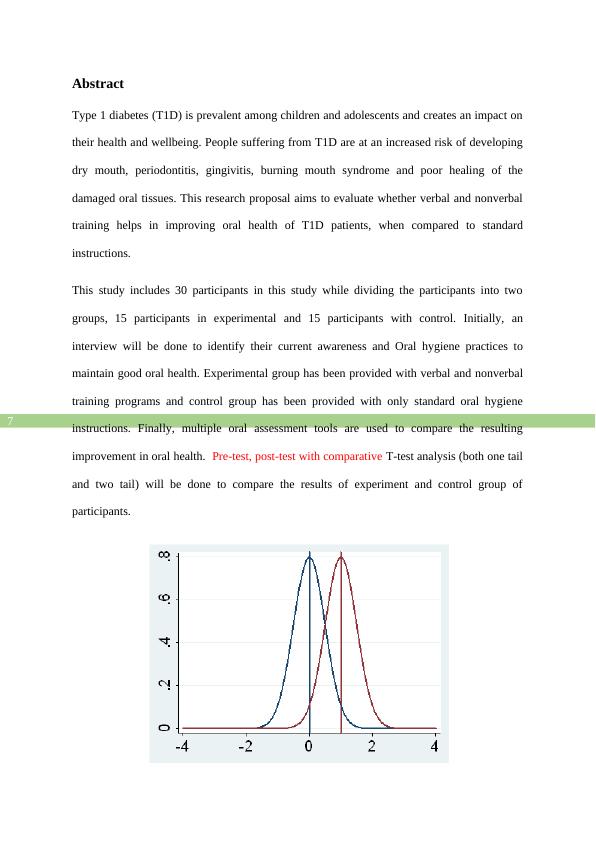
8
Figure 1
This figure shows two tailed t test with the significance (p value in x axis) and degree of
freedom (in y axis).
From this research it has been found that there is a significant difference in oral health
condition between the participants provided with extensive verbal and nonverbal training and
participants provided with only standard instruction. Therefore, it has been recommended that
through collaborative partnership of private and public organizations, verbal and non-verbal
training in Oral hygiene instruction for the patients with T1D helps in improving the Oral
health.
Declaration
No portion of the work referred to in the dissertation has been submitted in support of an
application for another degree or qualification of this or any other university or other institute
of learning.
Figure 1
This figure shows two tailed t test with the significance (p value in x axis) and degree of
freedom (in y axis).
From this research it has been found that there is a significant difference in oral health
condition between the participants provided with extensive verbal and nonverbal training and
participants provided with only standard instruction. Therefore, it has been recommended that
through collaborative partnership of private and public organizations, verbal and non-verbal
training in Oral hygiene instruction for the patients with T1D helps in improving the Oral
health.
Declaration
No portion of the work referred to in the dissertation has been submitted in support of an
application for another degree or qualification of this or any other university or other institute
of learning.
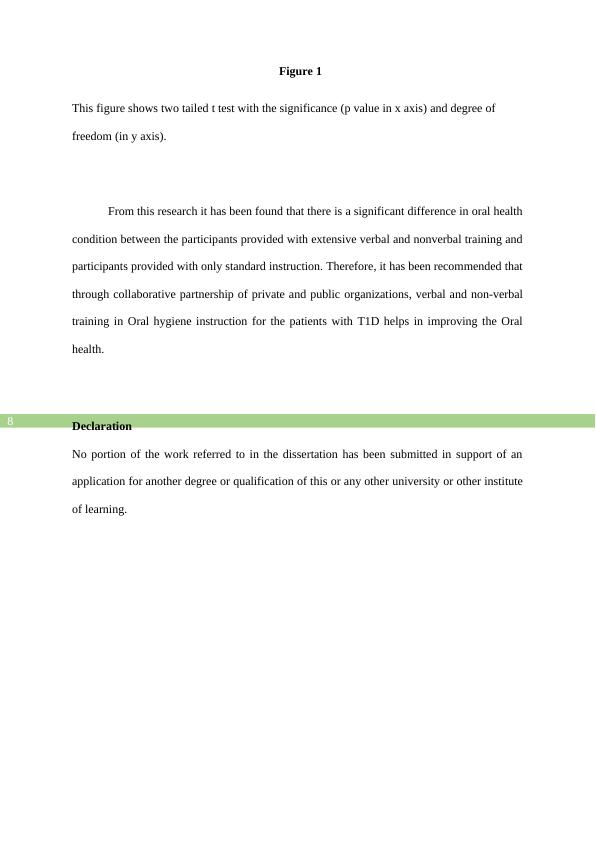
End of preview
Want to access all the pages? Upload your documents or become a member.
Related Documents
Materials and Methods Case Study 2022lg...
|21
|4371
|19
Oral Health Assessment Programlg...
|6
|1397
|25